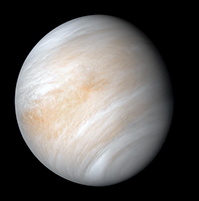Your Ticket to the Universe
March 30, 2023
There’s been lots of buzz about the recent planetary parade, but you don’t need the planets to align to satisfy your cosmic curiosity—UT Physics and Astronomy is always your ticket to the universe.
Venus, Mars, Mercury, Jupiter, and Uranus lining up in the western sky generated lots of interest and there’s still more to see, with fantastic opportunities right here on campus.

Venus (NASA/JPL-Caltech)
Paul Lewis directs astronomy outreach for the department and said though the planetary parade is over, Venus and Mars are still observable in East Tennessee.
"It’s impossible not to see Venus, as it’s the brightest of all the planets and is about 30 degrees above the Western horizon at sunset," he said. "Mars is high in the sky at sunset but is more than one and a half times farther from us than the sun, so it is pretty faint. It still has a reddish tint to it, so you should be able to catch it just to the right of the leftmost foot of the Gemini twins, who are facing us."
Also in the neighborhood is the Messier 35 (M35) open cluster of stars. Lewis said amateur astronomers should be able to see this collection with a pair of binoculars. A sweep farther to the right of M35 offers a view of three more open clusters: M36, M37, and M38.
"Mars has a lot of company, it would seem," he said.

Paul Lewis
Lewis recommends downloading a free planetarium program called Stellarium to make finding these objects easier and to learn something about the night sky at the same time.
"We use Stellarium in our astronomy labs and it runs our planetarium," he explained.
There’s no need to navigate the sky entirely on your own, however. The department is eager to share expertise and resources with the public.
Lewis organizes public astronomical observations on the roof of the Alvin H. Nielsen Physics Building on the first and third Fridays every month, weather permitting. There’s also a 32-seat planetarium for visits from local school groups, scouts, home schoolers, church groups or any group looking for an hour or so under the stars, indoors, rain or shine.
There are also special viewing opportunities when there are cool events—or sometimes hot ones—in the sky.
"We are planning to start conducting solar observations on weekends in the near future," Lewis said. "The sun has been, for the last few months, spectacularly active. Sunspots galore have danced across the face of the sun, popping off solar flares and spewing beautiful prominences all around the edge of the solar disc. We use special Hydrogen-alpha telescopes to see these beautiful features. We can also observe sunspots with white-light filters. You will not be disappointed. Solar observing is truly thrilling."
Anyone can share the wonders of the night (or day) sky, especially here in Tennessee.
"If nothing else, we encourage you to get out on your own or join us for views of the night skies over Knoxville," Lewis said. "There is always something to see. And remember, if you don’t look up, you won’t see a thing."
- To schedule a planetarium visit, please contact Paul Lewis at 865-974-9601.
- Hit the Roof!
- The department hosts observations from the roof of the Alvin H. Nielsen Physics and Astronomy Building on the first and third Fridays of every month, weather permitting. We are located on the “the Hill” off Cumberland Avenue between 13th Street and Phillip Fulmer Way.
- Parking is available in the Volunteer Hall Parking Garage on White Avenue.
- Some handicapped parking is available in front of the physics building.
- Observing begins at 9:00 PM.
- Don't forget to check the weather!